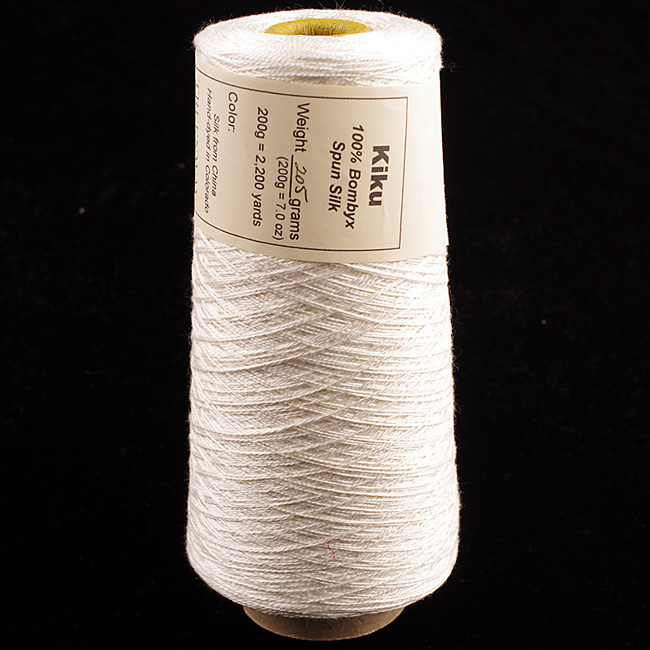Silk Yarns & Silk Blends
Silk yarns and threads are classed as either reeled or spun. Both types have different properties. Reeled is sometimes consider superior due to the very long fiber lengths. But spun silk has high qualities as well. Understanding the differences is important for you select the type which is best for your project.
Reeled Silk Yarns
Treenway Silks - Reeled Yarns
Lixue - Shop
100% Bombyx Reeled Silk Yarn, 3-ply Fine Cord
Yuki - Shop
100% Bombyx Reeled Silk Yarn, 8/2
Chilali - Shop
100% Bombyx Reeled Silk Yarn, 3-ply Medium-Fine Cord
Glasera - Shop
100% Bombyx Reeled Silk Yarn, #0
By Karen Selk
Reeled, or filament silk is the highest quality yarn and is very white and shiny. First the cocoons are inspected and sorted, as only those with a perfect shape can be used for the reeling procedure. Cocoons are soaked in warm water to soften the gummy sericin. The silken strand from a single cocoon is too fine to use alone, so individual filaments of 6-20 cocoons are unravelled at the same time, travelling through a very small eye. The softened sericin dries, hardens and binds the strands together to become one thread the size of a human hair.
In the past most of the select reeled silk was used by commercial production of silk fabric. But recently the relatively heavy reeled silk yarns have become available to handweavers. They can be extremely slippery and require some special handling. A ball winder should not be used with reeled silks. The yarn will slip off, making a tangled mess. Wind the balls by hand, or better still, wind your warp and shuttle directly from the skein placed on a yarn holder (swift). It is best to clamp the swift sideways rather than upright. Investing in a couple of swifts and bypassing the ball stage saves time and tangle no matter what type of silk yarn you are working with.
Reeled Yarn Count
The count of reeled yarns is based on denier, a unit of measurement used to arrive at the diameter of a strand of silk. One denier (D) = 1 gram (g) weight which measures 9,000 metres (m) of filament. Translated into the imperial system this is: 1D = 9,750 yd (or just over 5 miles) of silk filament weighing 1/28 of an ounce. A strand of silk from an average cocoon is 2–3 denier and barely discernible by the human eye. A D 20/22 yarn is comprised of filaments from 8 cocoons which may be as thick as a hair from your head.
The count numbers describing reeled yarns are complex technicalities of trivial interest. The thickness and twist are the real important factors when embarking on a project. The best way to decide on the suitability of a yarn for our purposes is to look at a sample and the yardage it has. These factors will help determine set and hand. Reeled silk that has any kind of twist added is called thrown silk. There are two kinds of thrown silk: organzine, which is tightly twisted and plied and used as warp; and tram, which is given only a slight twist and used as weft.
Spun Silk Yarns
Treenway Silks - Spun Yarns
Arabella's Web - Shop
100% Bombyx Spun Silk Yarn 120/2
Zola - Shop
100% Bombyx Spun Silk Yarn, 12/2 (gentle twist)
Kiku - Shop
100% Bombyx Spun Silk Yarn 20/2
Taiyō - Shop
100% Bombyx Spun Silk Yarn 30/2X5
Myõjõ - Shop
100% Bombyx Spun Silk Yarn 60/2
Margaret - Shop
100% Bombyx Spun Silk Yarn, 60/2X6
Yasulyn - Shop
100% Bombyx Spun Silk Yarn, 12/2 (firm twist)
Gekkõ - Shop
100% Bombyx Spun Silk Yarn 60/2X2
Jorie - Shop
100% Bombyx Spun Silk Yarn 20/2X5
Spun silk is made from the cocoon fibers which remain after initial reeling.The weak filament of the transparent silken envelope remaining from the reeling process, and the damaged, discoloured, or imperfectly shaped cocoons become the raw material for lustrous, creamy coloured spun silk yarn. This cocoon "waste" must first have the sericin removed (degummed) with soap and water. Next, the fibre is cut into uniform lengths and carded to remove short tangled bits as well as the brown pupa inside the cocoons. Combing lays all the fibres parallel in a sliver which is spun into a shimmering yarn. Spun silk is the most familiar yarn made available to handworkers. Wild silk is most often spun.
Tips for Handling
High quality spun silk is easy to work with though it is more slippery than cotton or wool. An empty toilet paper tube placed on the arm of a ball winder will keep the silk yarns tidy if they slip off the ball while winding. The yarn should be handled as little as possible while dressing the loom to prevent fluffing and pilling.
Spun Yarn Count
The count used for spun silk is the metric count system, used for cotton, linen and wool. In determining spun silk, 1 gram (g) (1/28 of an oz) is the stable figure. One metre (m) (39 inches) of yarn weighing 1g is 1m count or a #1 yarn. A #10 silk is 10m/g and has 10,000 m/kg. This translates to 4,970 yd/lb.
A pair of numbers identifies the size of plied yarns. A 20/2 spun silk is comprised of two strands (bottom number) of a #20 (top number) yarn. The 20 indicates that each strand is 20 times finer than a #1 silk, which has 497 yd/lb. To calculate the yardage of any spun silk yarn, multiply the yarn size by 497 and divide by the ply number. A 20/2 silk has 4970 yd/lb. The higher the number e.g. 20, 30, 60 the thinner the yarn and greater the yardage.
Noil or Bourette Spun Yarns
Short fibres containing crushed pupa left behind after making higher quality spun silk are made into noil yarn. The shortness of fibre length results in a lack of lustre and body. This is lower quality spun yarn using the same metric count system as the above spun silk. Noil has the strongest silk odour due to impurities in the yarn. The majority of the smell dissipates after washing, but can return again when wet.
Higher quality noil yarns are easy to use. Noil has a soft natural touch. If you use noil for weaving it is a good practice to tug on a noil yarn to be sure of its practicality as a warp. The majority of plied noils can be used for warp but most single-ply noil yarns are too easily broken to withstand warping, though work well as weft.
The term 'noil' is also used in regards to combing wool. Silk noil is also called "raw silk", although that is a misnomer. As noil is a relatively short fiber, fabric made from noil.
Reeled or Spun - Twist & Ply
Within each type of yarn there are variations of twist and ply which give them different characteristics suitable for different purposes. Sheen is affected by twisting and plying. A yarn surface with the least interruptions will reflect the light for optimum sheen. The more twists and plies in the yarn, the more the surface is broken so there is less sheen.
Reeled or Spun - Piling
Plies and twists have a lot to do with how readily a silk yarn will pill or pull.
Pilling occurs with many good yarns that contain short fibres: cashmere, merino, qiviut and spun silk. Through use, the shortest fibres work their way to the surface, break off and form a little sticky pill. Plied yarns pill less than singles and yarns with more twist pill less than loosely twisted yarns. Gassing is the process of running the finished yarn through a flame at very high speed to burn off the fuzz which helps prevent pilling. All of Treenway's yarns have been gassed.
Pilling is not an issue with reeled silk as only long fibres are used. However, these yarns are not without their own troubles. The heavier reeled yarns available to handweavers are made of numerous fine filaments. The rough edge of a table or jewellery clasp can easily catch just a few of the filaments. Yarns with a tighter twist will help avoid that problem.
Both spun and reel yarns can be twisted into a cord, which is a plied yarn with a firmer twist. These yarns have less chance of pilling or pulling, but make a slightly stiffer cloth.
Combining Silk With Other Fibers
By Karen Selk
Combining the Blended Yarns
All of these fabulous blends are stunning woven on their own or mixed and matched together for even greater, more exotic diversity. Men particularly like the handsome fabric made with natural coloured silk/yak in one direction and silk/camel in the other. Another distinguished mix for men is the beautiful silvery silk/yak as warp with black 30/2 silk as weft. The softness of hand and colour of silk/camel woven with silk/cashmere is delicious. Silk/ramie woven with 30/2 silk or silk/cotton is a perfect fabric for summer wear. The exciting mixes goes on.
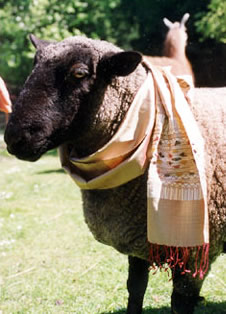 Photo by Karen Selk
Photo by Karen SelkDyeing Silk Blend Yarns
Some dyes work best on protein fibres and others work better on vegetable fibres. When blended yarn has both protein and cellulose fibres, one of them will not accept the dye as readily as the other. Often the appearance is heathered, giving it an added dimension. When different protein fibres are blended together, they accept the dye beautifully. Some blends may look like they accept more dye than others.
As glorious as silk is, sometimes a marriage with other fibers is practical and enhances both fiber types.
These unions can be made in two ways: blending fibers in the carding process before it is spun into yarn (see listing of Treenway Yarns) or using a mixture of different fibers in a woven item.
Each fiber shrinks at a certain rate, however. Group only one or two ends of the same fiber together so that individual yarns must compromise and settle in harmony. If many threads of the same fiber are grouped together in bands, the result may be unsolicited seersucker. It is safe to use one yarn type in the warp and another in the weft. Each direction can shrink as it likes without affecting the other.
Silk 55% / Angora (Rabbit) 45%
Shop Silk Angora Yarn
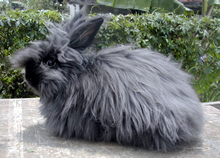
Rabbits of many colours, specially bred for long fur, provide Angora fibre. There are a number of different breeds, each with distinctive characteristics. Angora rabbits have two types of fibre in their fur. The outer layer is longer with shiny, stiffer guard hair, which protects the inner fibres. The inner layer is thick and fluffy to keep the rabbit warm. The different breeds have varying amounts of these fur layers. The rabbit fur is removed by plucking or shearing three to four times a year. Small-scale growers usually pluck the rabbit, which is believed to give the best quality fibre. This is not feasible on a commercial level, where the rabbits are shorn. Neither process hurts the rabbit.
The fur of the rabbit is very fine, soft, lightweight, has great insulation qualities (it is seven to eight times warmer than wool) and can have a silky texture depending on the breed. Angora can be difficult to spin, the fur can felt if not stored properly and it is excessively warm. It benefits greatly mixed with silk to provide length, sheen, less pilling and practicality in price and uses. Silk's softness, warmth and luxury are increased. The soft, strong yarn is delightful to weave and provides a warm, soft fabric that is lovely for scarves and other garments.
Silk 60% / Bamboo 40%
Shop Silk Bamboo Yarn
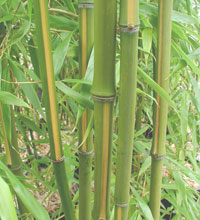
There are over 1,000 types of bamboo which grows all over the world. It is a renewable resource that is extremely fast growing, ready for harvest in 1–4 years, generates more oxygen than trees and is exceptionally hardy, tolerating drought and drowning.
The bamboo fibre is filled with micro gaps and holes enabling it to absorb and evaporate perspiration quickly, making it cool, breathable, anti–bacterial and good summer wear. The fibre is easy to straighten and spin with good tensile strength and abrasion that dyes easier than cotton.
The bamboo "stems" are crushed for processing. Bamboo is composed of 20% starch which is broken in an alkaline solution before processing the fibre.
Blending bamboo with silk brings a cool and crisp almost papery feel to the silk while softening the bamboo. The silk/bamboo yarn combines nicely with silk/cotton, silk/ramie or 100% silk for nice summer weight fabric.
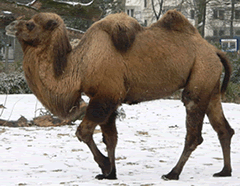
Silk 55% / Camel 45%
Shop Silk Camel Yarn
The majority of camel hair comes from the two-humped Bactrian variety, which survives in extremely cold climates. Camel hair is comprised of two qualities: relatively coarse outer hair and inner down fibre. Shearing, combing or collecting the hair shed during molting season are the different ways of obtaining the fibre. Fibre length is approximately 1 – 1½ inches with the best coming from Mongolia and Inner Mongolia. An expensive process of separating the long coarse hair from the down, called dehairing, is necessary before spinning yarn. The longer hair is used in making felt for Mongolian yurts. The camel down keeps the camel warm so the fibre is lightweight and warm with a nice lustre.
The short fibre acquires length, shape retention sheen and durability when blended with silk. The silk attains a beautiful tan colour, softness and warmth. The yarn is strong, yet cuddly and scrumptious to weave. The cloth has a nice drape, soft and warm hand that makes yummy unisex scarves and sweater/jacket weight fabric.
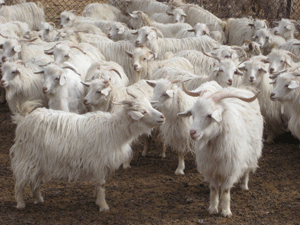
Silk 80% / Cashmere 20%
Shop Silk Cashmere Yarn
The high Himalayan Mountains of Asia are the origin of the Cashmere goat. China is the largest producer of cashmere and maintains the best fibre comes from the extreme cold of Inner Mongolia. It is the fine undercoat ranging in colour from deep brown, grey and white we prize for its feel. Cashmere fibre is combed from the goat during the spring molt in China and Inner Mongolia. The outer guard hair is clipped first making it easier to comb out the 1 – 3 inches down. Shearing is preferred in Western countries, which can produce second cuts and leave precious down behind. The costly dehairing process is necessary to separate the guard hairs from the undercoat before spinning. Cashmere is luxuriously soft, fine and lofty providing lightweight warmth. The addition of silk makes cashmere more affordable and durable as well as adding luster. Cashmere provides silk a downy softness. The yarn produced by this luscious marriage weaves like a dream, providing a plush drapable fabric suitable for scarves or clothing.
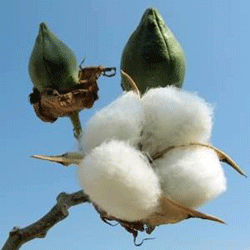
Silk 55% / Cotton 45%
Shop Silk Cotton Yarn
Cotton is a cellulose fibre derived from the seed of the plant, similar to milk weed fluff. The cotton plant is a tropical and subtropical shrub. After the plant finishes flowering, a seedpod or boll forms. The mature boll opens to let in air to further dry the seeds. It is important to harvest at this time before rain. A downy fibre, called lint, surrounds the seeds inside the boll. Separating the lint from the seed was a difficult job made much easier by the invention of the cotton gin, which squeezes and "saws" the seed from the fibre. The fibre is graded for length, uniformity, colour and fineness. Carding aligns the fibres, removes foreign matter and short fibers before spinning. Higher quality cotton is also combed before spinning, providing a stronger, more uniform, smoother fibre with greater lustre.
Cotton is the most consumed of all the natural fibres due to its versatility, high performance and appearance. It is soft, flexible, comfortable, strong, absorbent, washes easily and has a fair amount of elasticity. Short staple length and depletion of soil nutrients are it's weakest properties. Silk blended with cotton adds more length, elasticity and shine to the cotton and is more affordable than 100% silk. Yarn of the combined fibres is a pleasure to weave, with the hand of cloth being soft, smooth and cool, perfect for summer garments and scarves.
Silk 55% / Ramie 45%
Shop Silk Ramie Yarn
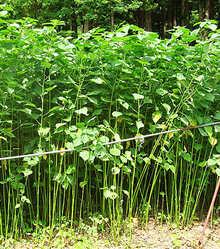
Ramie is a bast fibre, similar to linen and hemp. It is in the nettle family and has been touted as the strongest vegetable fibre. The plant is cut above the root, just before flowering. The many steps necessary to separate the fibres from the natural gum and woody matter of the plant stalk are called retting. The stalks are soaked and rotted for days, then scraping takes place to obtain "clean" fibre and finally washing and drying to reach the spinnable 4" – 72" fibres. Ramie"s job in the field is to carry water up the stalk. The result created a very absorbent fibre.
Ramie is durable, lustrous, strong, easily washed and becomes smoother and more pliable after each laundering with good rot resistance. It is labour intensive to produce, stiff and has poor elasticity and wrinkle recovery. The blending of ramie with silk brings a touch of body to the silk while softening the ramie. Silk adds a great deal of wrinkle resistance and elasticity to the ramie. The blend is easier to weave than 100% ramie with the hand of cloth being crisp and soft at the same time. It is perfect for summer garments.
Silk 60% / Wool 40%
Shop Silk Wool Yarn
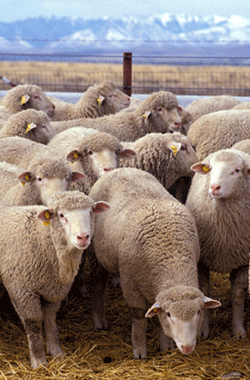
There are hundreds of breeds of sheep raised all over the world, which produce a great variety of grades and types of fleece. The range is extreme, from super fine merino used in making fine clothing to coarse hairy wool for carpets. Wool is a protein fibre with the unique feature of being covered in overlapping scales, which gives wool the ability to felt. Sheep are usually shorn annually in the spring. The full staple length is used to make yarn. The fleece is graded, washed, carded and spun into yarn suitable for a variety of things.
Wool is strong, resilient and warm, absorbing 50% of its weight in moisture before becoming saturated and is wrinkle resistant. It is easy to spin and dye. Wool and silk improve from their union with wool becoming smoother, shinier, more drapeable and easier to wash without fear of felting, while silk acquires resilience and warmth. The yarn is a joy to weave and yields a firm, but supple cloth good for all types of clothing.
Silk 55% / Yak 45%
Shop Silk Yak Yarn
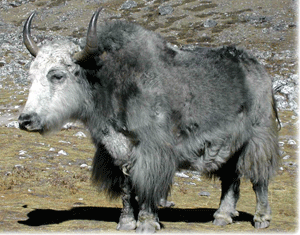
Yak is a valued beast of burden living above the snowline in the Himalayan Mountains. It provides meat, milk, hair and hides to the people living there. Its long shaggy coat reaches the ground. The soft undercoat is combed out at the time of the spring molt. The fibre length varies from 1–1½ inches. Separating the guard hairs from the down is a slow, necessary process before spinning fibre, which is nearly as soft as cashmere. The longer hair is used in rope making, mats, sacks and covering huts. The undercoat of the yak keeps it warm in extreme cold, so the fibre is warm and lightweight with a luster.
Silk lends the delicate down substance, sheen and elasticity at the same time becoming softer and warmer with a lovely soft brown/grey colour. This exotic blend is heavenly to weave yielding a soft drapeable cloth with especially beautiful colour, just perfect for light jacket weight or unisex scarf.

